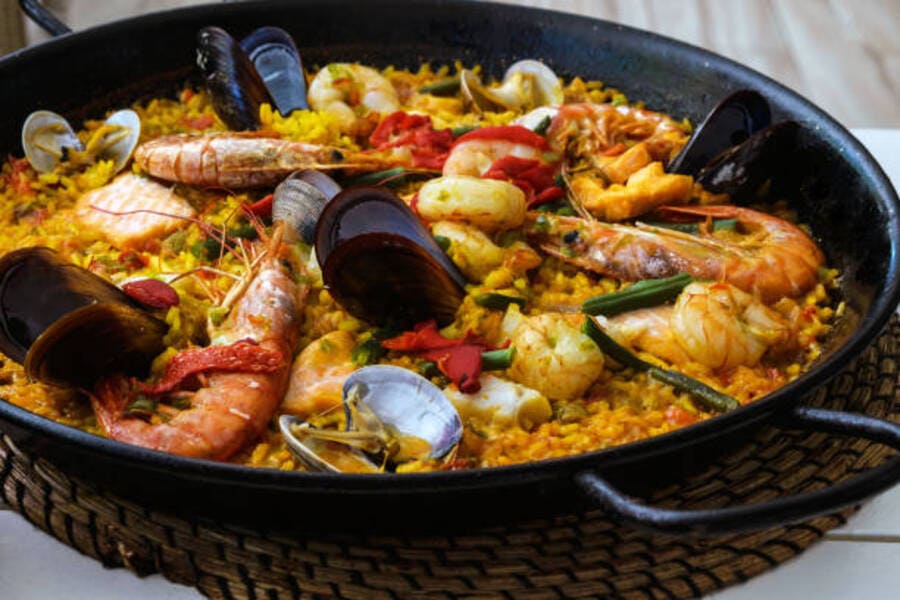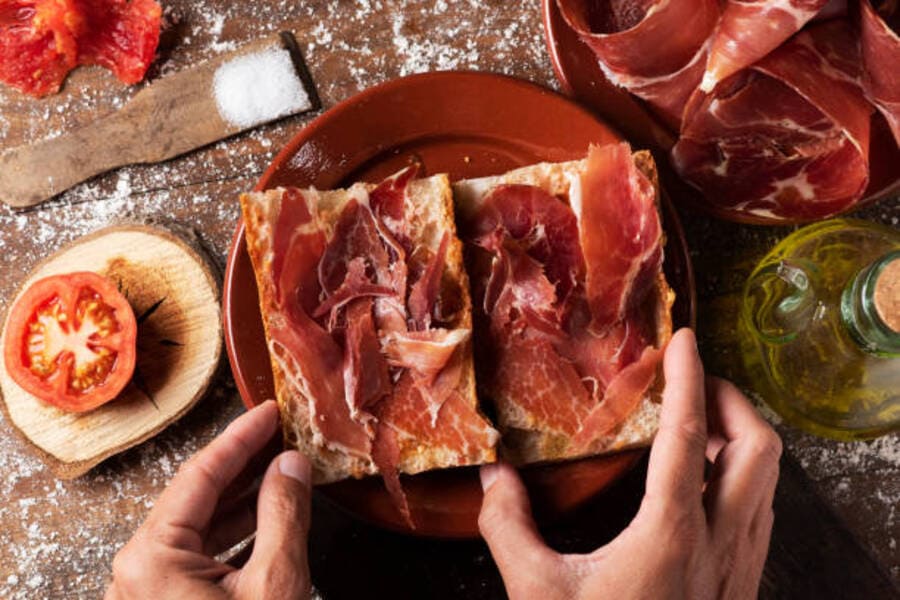Catalonia, located in the northeastern region of Spain, is known not only for its rich cultural heritage and stunning landscapes but also for its gastronomy which is deeply rooted in its history and traditions. Drawing influences from Mediterranean, Spanish, and French cuisines, Catalonia’s gastronomy is a true reflection of the region’s diverse cultural background.
The local-based offer of fruits in Catalonia, particularly in places like Mercat del Lleó in Girona, showcases the region’s commitment to sustainable and locally sourced ingredients. By supporting local farmers and promoting the consumption of seasonal fruits, Catalonia is not only preserving its culinary heritage but also contributing to environmental sustainability.
Moreover, Catalonia’s gastronomy plays a significant role in promoting tourism and attracting visitors from all over the world.

Barcelona, the capital city of Catalonia, has become a hotspot for creative tourism that revolves around gastronomy. Visitors to Barcelona can indulge in a variety of activities that not only allow them to taste the unique flavors of Catalonia but also provide them with opportunities for active involvement and learning experiences.
One example is cooking classes where participants can learn how to prepare traditional Catalan dishes under the guidance of local chefs.
These immersive culinary experiences not only provide tourists with a memorable and enjoyable vacation but also deepen their understanding of the cultural uniqueness of Catalonia.

The cuisine of Catalonia, and particularly Barcelona, is known for its variety and richness. Some of the most popular and traditional dishes of the region include:
- Pa amb tomàquet: A slice of bread rubbed with tomato, seasoned with olive oil and salt.
- Escudella i carn d’olla: A stew made with pork, beef, chicken, potatoes, chickpeas, vegetables, and noodles.
- Fideuà: A dish similar to paella, but instead of rice, short and thick noodles are used.
- Butifarra con judías: Pork sausage with white beans.
- Calçots with romesco sauce: A variety of tender onion roasted over the coals, served with a sauce made with tomato, garlic, almonds, and olive oil.
- Crema catalana: A dessert made with milk, egg yolk, sugar, and cinnamon, and then caramelized on top.
In addition to these dishes, Barcelona is also known for its wide selection of fresh seafood and fish, as well as its famous tapas and local wines.
Markets
There are more than 40 municipal markets in Barcelona. The largest of them La Boqueria, Sant Antoni and El Born (now closed), are impressive late 19th-century iron-and-glass structures built on the site of former monasteries. These cathedrals to food are ideal places to display Catalonia’s wide variety of produce from the mountains, rich farmlands and the sea, often sold by third-and fourth-generation vendors. In recent years, however, tradition has been giving way to trend, with juice bars and fusion food, and prices, particularly in touristy La Boqueria, have been rising. Santa Caterina and Barceloneta have been dramatically overhauled, Sant Antoni is next.
Elsewhere, squares and open spaces are put to use with regular stamp, book, craft, antiques and bric-a-brac markets. The latest is the lively multicultural weekend market in Rambla del Raval.
Where to eat market produce
For a visitor, much of the food on offer at the city’s markets is merely for looking at. Fresh bread, olives, cheese and charcuterie make for a delicious impromptu picnic, but really to savour the range of produce, visit the market cafés and restaurants.
Many of the established ones are institutions. In La Boqueria, Pinotxo, run by the Bayen family, opens at 6am and specialises in oysters and cava. Foodies gather for breakfast from 8am at Quim de la Boqueria towards the back of the market, where Quim Márquez produces innovative dishes. In Mercat Santa Caterina, Cuines Santa Caterina, from the Tragaluz group, serves inexpensive fusion food as well as traditional dishes in a cool, modern tapas bar and restaurant. Mercat de Barceloneta has also become trendy with the opening of Els Fogons de la Barceloneta and Michelin-starred Lluçanès by chefs Frances Miralles and Angel Pascual, serving seafood such as tartar of escalopes with white truffles.
A passion for food
In Barcelona you will find some of the best food in Spain.
An abundance of fresh fish, superb meat and cheese, a cornucopia of great vegetables, plus Catalan inventiveness, have produced a distinctive and delicious cuisine.
No one should visit Barcelona without Catalan food. The experience would be incomplete otherwise, and any assessment of its people merely superficial.

Eating is an important part of Catalan culture, something to be valued, taken seriously and enjoyed to the full, in true Catalan style.
The acerbic political commentator and eminent writer Manuel Vázquez Montalbán was passionate about food; he bestowed a certain grace on any restaurant where he chose to eat.
In his opinion, “Catalan cooking is one of the most distinguishing signs of the national identity.” It is also a composite of the nation’s past, embodying the many influences of the different peoples and cultures that have swept through, settled in or bordered Catalonia, to say nothing of the lands dominated by Catalonia over its millennial history. The original fusion food, perhaps.
Nature’s bounty
Catalan cooking is also a reflection of the geographical and physical characteristics of the country. Many dishes are based on the nuts, garlic, olive oil, tomatoes, herbs and dried fruits that are indigenous to these lands. Catalans are justifiably proud that their country can offer miles of rugged coastline and sheltered beaches, as well as awesome mountain ranges and rich valleys, and all within easy reach of each other.
Similarly, the cooking combines the natural products of the sea, the fertile plains and the mountains in a style known as mar i muntanya (sea and mountain). It makes for strange-sounding, though delicious, marriages on the menu, such as mandonguilles amb sèpia (meat-balls with cuttlefish), or gambes amb pollastre (prawns with chicken).
Simple pleasures
The health-giving properties of a Mediterranean diet are almost a cliché these days, and a selling point in many an advertising cam-paign, but here such a diet still exists in a pure, unadulterated form. One of the most famous Catalan dishes is perhaps the most simple, yet one of the best: the ubiquitous pa amb tomäquet.

This fresh “peasant” bread rubbed with tomato, a trickle of virgin olive oil and a pinch of salt is the Mediterranean answer to northern Europe’s thinly sliced bread and butter, and not surprisingly provokes a certain amount of southern pride.
OCTOBER HARVEST
October is a great time to be in Barcelona, because it’s mushroom season, when fans of wild fungi will be in their element. The market stalls are rich in autumnal colours, and the smell of damp woods is intoxicating.
The generic name for the various wild mushrooms is bolets. Rovello is one of the best, especially just grilled with garlic and parsley, but also delicious in stewed meat dishes at this time of the year. For the best range of fresh, dried (or, if need be, frozen) mushrooms, and unusual fresh herbs, go to Petras, Fruits del Bosc, at the very back of La Boqueria market. Ignore the arrogant service and enjoy the superior products.
Local specialities
Look out for menús that include any of the following: as starters, arròs negre, black rice, a more interesting version of paella made with squid and its ink; escalivada, grilled peppers and aubergines dressed with oil; esqueixada, salad of raw salt cod, onions and peppers; xatò, a salad from Sites of frisée lettuce with tuna, salt cod, anchovies and a romesco sauce; espinacs a la Catalana, spinach sautéed with raisins and pine nuts; faves a la Catalana, small broad beans stewed with herbs, pork and sausages (best in spring); canalons, a Catalan tradition brought from Italy, always eaten on 26 December; fideuä, an excellent and lesser-known variation on paella, noodles cooked in a fish stock; and a strictly winter dish, escudella, the most traditional Catalan soup, usually small followed by carn d’olla, that is, the meat and and vegetables that have been cooked to make the ralan soup. Now a traditional Christmas dish, this used to be part of the staple diet of every Catalan household.
The main event
Among the main courses, be sure to try the very Catalan botifarra amb mongetes, a tasty sausage served with haricot beans; fricand braised veal with moixernons, a small, delicate wild mushroom; bacallà, salt cod serve. in many ways such as a la llauna (garlic, parsley and tomato) or amb xamfaina (tomato. pepper and aubergine sauce, also served with meat); suquet, a seafood stew; calamar. farcits, stuffed squid; oca amb naps, goos with turnip; conill, rabbit, either grilled and served with allioli, or stewed; xai, lamb – the cutlets (costelletes) are especially good.
Fish and shellfish should not be missed in Barcelona: the simplest and perhaps the best way is grilled (a mixed grill is a good option for two) or done in the oven, al forn. It is worth going to a good restaurant for a paella; cheap imitarions are usually disappointing.
If you have any room for dessert, don’t miss the famous crema catalana, a cinnamon flavoured custard with a burnt caramel top Other traditional postres include mel mato, a curd cheese with honeys, a mixture of roast nuts and dried fruits, usually served with a glass of sweet moscatel; and macedonia (fruit salad).
PASTRY HEAVEN
In Barcelona the number of pastry shops per square meter must rank among the world’s highest. For each feast day and festival there is a corresponding traditional sweetmeat: bunyols (a small doughnut) during Lent, la mona (a sort of brioche, often with fancy decorations) for Easter, panellets (little marzipan cakes decorated with pine nuts) for All Saints and for cas-tanyades (autumnal parties centred on roasting chestnuts). Throughout the summer months the different neighbourhood and village feast days are celebrated with fireworks, cava and cocas (pastries covered in sugar, crystallised fruits and pine nuts).
WINE
The reputation of Spanish wine has changed enormously in recent years, and Catalonia is one of the regions that is now attracting attention from international connoisseurs as well as visitors with a taste for the good things in life
There was a time when Spanish wine meant to have any international acclaim was Rioja.
Today, these misconceptions are in the past, and anyone who appreciates a decent glass of wine will be aware that Spain has many different wine-growing regions, producing a range of interesting and increasingly high-quality wines.
Catalonia’s wine regions
One of these is Catalonia, which itself has 10 wine regions officially classified as D.O.
(Denominació d’Origen, similar to the French appellation contrôlée): Empordà-Costa Brava, near the French border; Alella, in the Maresme, area known for its white wines, on the outskirts of Barcelona; the well- known Penedes, to the southwest of Barcelona; the most recent, Pla de Bages, near Manresa; Conca de Barbera, with its modernista wine cellars, in Tarragona; Costers del Segre, home of Raimat wines, co the west in Lleida; and Tarragona, Terra Alta, Montsant and the Priorat with terraced vineyards on steep, slatey hillsides in the south.
In a bid for stronger identity in the international market, a recent controversial move by the large companies backed by the Generalitat (Catalan autonomous government) to introduce a denomination for the region as a whole, D.O. Catalunya has been successful.
The home of Cava
Ninety-five percent of Spain’s cava is produced in Catalonia and the greater part from the Penedès where it was crealed by Josep Raventos in 1872.
From that celebrated first bottle grew the Codorniu empire, which along with Freixenet leads the cava industry. This sparkling wine, made by the méthode champenaise, is obligatory al fiestas and a ubiquitous companion to Sunday lunch when it is served with dessert) One of the world’s great sparkling wines, cava is warmer, earthier and less acidic than champagne.
Overall, Catalan cuisine is highly appreciated for its combination of flavors and textures, and is an integral part of the culture and culinary heritage of the region.





